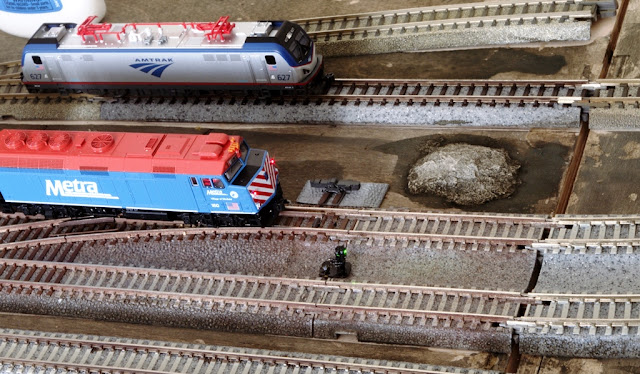T-Trak allows domino-style layout design using manageably small modules and standard Unitrack components. The layout base can be inexpensive and easy-to-place folding tables. However, most T-Trak layouts are temporary, assembled at modular railroad meets. This is very limiting, and the limits are reflected in the T-Trak standards: the double-track ovals are to be wired for opposite-polarity opposite-directional DC operation. This means that the typical module meet layouts run large double-track circuits with the main lines running trains in opposite directions.
I guess this is fine for weekend type shows that have the object of maximum throughput for member trains. The roundy-roundy operation doesn't get old if you're just doing it for the weekend. But think of what's left out.
For instance, Unitrack has both single and double crossovers, but opposite-polarity wiring means you can't use them between main lines if you follow the T-trak standards. (If you could use them, you'd definitely have to have a dispatcher, though, which could make things impossibly complicated for a weekend show.)
But a home layout built to the physical T-Trak standards but without the limiting wiring requirements is a very different matter. In addition, the way David Popp built the MRVP T-Trak modules takes away a key advantage: he built them with a solid floor but filled the volume of the box with styrofoam. This leaves out the ability to place various electrical components under the layout surface:
This in turn lets you take advantage of additional DCC features like stationary decoders, which work very well with Unitrack. You can also start to add signals and at least rudimentary signal controls:
But I'm also noticing a school of modeling where guys aren't afraid to cross oceans and include Amtrak, TGVs, Shinkansens, and the like on one layout. Especially for T-Trak, this is appealing. The MRVP T-Trak modules followed prototypes from the Canadian rockies though the midwest down to coastal Florida, and somehow it all worked. No reason you can't add a little bit of France!
On a trip to France in 1995, I found some N scale French signals. French signals are miniature Eiffel towers and incredibly complex. Here are some prototype shots I got on that trip:
Here are two of the French N signal models I have:
I've added a blog called Quinntopia to my blogroll -- the guy has a similar philosophy to mine in N. My French signals will look great with TGVs!







Look at you! Two scales, two layouts, many projects and it's all coming together very nicely. This is model railroading Utopia!
ReplyDeleteNice job on Ntrak module. I really like the new Amtrak electric. Longs strings of passenger cars look great in N scale!